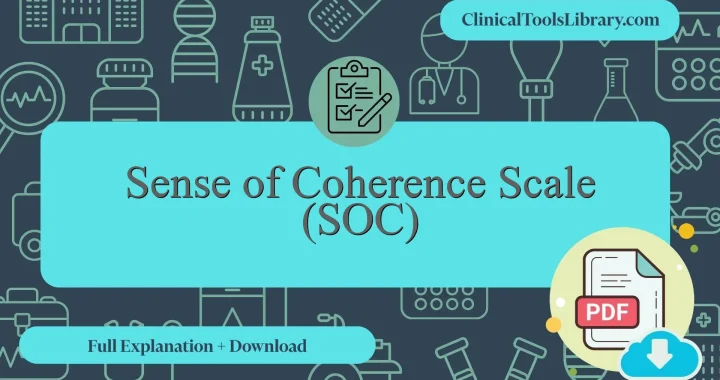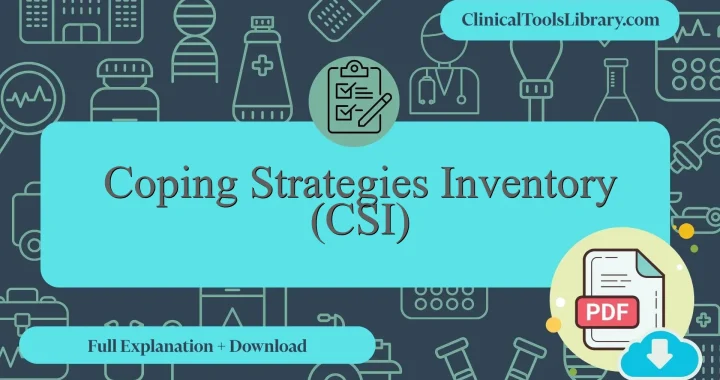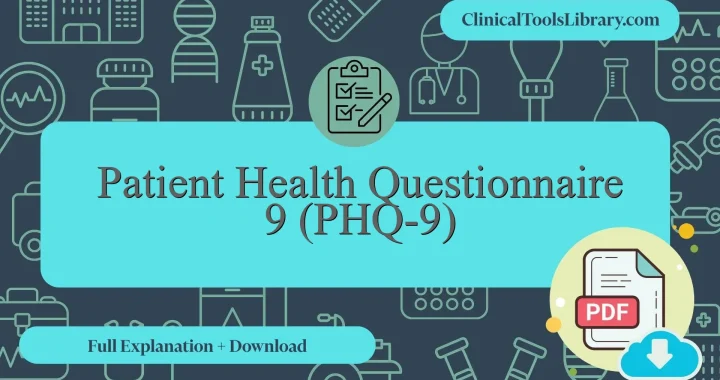In this article, we explain everything you need to know about the Sense of Coherence Scale (SOC). We will cover the aspects it evaluates, the target population, a detailed step-by-step explanation, and how to interpret its results. Additionally, we will dive into the scientific evidence supporting this tool (diagnostic sensitivity and specificity) in clinical assessment. You will also find official and unofficial sources available for download in PDF format.
What does the Sense of Coherence Scale (SOC) assess?
The Sense of Coherence Scale (SOC) is a validated psychometric instrument designed to assess an individual’s capacity to respond to stressful situations by measuring three core components: comprehensibility, manageability, and meaningfulness. Its primary purpose is to evaluate how people perceive life challenges and maintain health through effective coping strategies, making it relevant in the context of chronic diseases and mental health research. The SOC questionnaire, available in various formats including the Sense of Coherence Scale SOC questionnaire PDF, facilitates standardized scoring, which supports healthcare professionals in interpreting resilience levels and predicting health outcomes. The scale’s scoring system, detailed in the Sense of Coherence Scale SOC scoring PDF, enables objective quantification of an individual’s orientation to life stressors, thereby contributing to tailored interventions in clinical practice and public health settings.
For which type of patients or populations is the Sense of Coherence Scale (SOC) intended?
The Sense of Coherence Scale (SOC) is primarily indicated for patients experiencing chronic conditions such as cardiovascular diseases, cancer, and psychosomatic disorders, where assessing resilience and coping mechanisms is critical. It is extensively utilized in clinical contexts focusing on rehabilitation and mental health, aiding healthcare professionals in evaluating a patient’s capacity to manage stress and maintain well-being. The instrument’s standardized format, available in versions like the Sense of coherence scale SOC questionnaire pdf, facilitates objective measurement and tracking of psychological resources over time, thereby informing tailored intervention strategies. Its reliability and validity have been substantiated across diverse populations, making it an essential tool in both research and clinical practice for complementing traditional diagnostic assessments.
Step-by-Step Explanation of the Sense of Coherence Scale (SOC)
The Sense of Coherence Scale (SOC) consists of 13 items designed to assess an individual’s capacity to respond to stressful situations effectively. The scale includes questions that evaluate comprehensibility, manageability, and meaningfulness, which are the three core components of the SOC construct. Each item uses a 7-point Likert-type response format, ranging from extremes such as “very often” to “very seldom or never,” allowing for nuanced self-assessment. The administrator should instruct the participant to read each statement carefully and select the response that best reflects their typical feelings or attitudes. Scoring involves summing item responses, with higher total scores indicating a stronger sense of coherence, which has been linked to better coping strategies in managing chronic diseases such as cardiovascular disease and diabetes mellitus. Proper administration ensures reliable data collection for research or clinical evaluation of psychological resilience.
Download PDF: Original & English Sense of Coherence Scale (SOC) with Scoring Guide
Downloadable resources include both the original and English versions of the Sense of Coherence Scale (SOC) provided in PDF format. These materials facilitate comprehensive assessment through the Sense of coherence scale soc questionnaire pdf and its corresponding scoring guide. Healthcare professionals can utilize these standardized tools to reliably measure patient resilience and coping strategies in various clinical contexts.
How to interpret the results of the Sense of Coherence Scale (SOC)?
The Sense of Coherence Scale (SOC) test provides a quantitative measure of an individual’s capacity to respond to stressful situations by evaluating three components: comprehensibility, manageability, and meaningfulness. Scores typically range from 13 to 91, where higher values indicate a stronger psychological resilience and a better ability to maintain health despite adversity. Reference ranges suggest that scores below 50 may denote a weaker SOC, correlating with increased vulnerability to stress-related disorders and poorer coping mechanisms. The total SOC score is calculated by summing individual item responses, each rated on a Likert scale from 1 to 7, according to the formula: SOC = Σ (item scores). In clinical practice, healthcare professionals use these results to identify patients at risk for chronic conditions influenced by stress, such as depression or cardiovascular disease, allowing for tailored interventions aimed at enhancing coping skills and improving overall treatment outcomes.
What scientific evidence supports the Sense of Coherence Scale (SOC) ?
The Sense of Coherence Scale (SOC), developed by Aaron Antonovsky in 1987, has undergone extensive validation across multiple populations and health contexts. Its reliability and construct validity have been confirmed through numerous psychometric studies, demonstrating consistent internal consistency with Cronbach’s alpha coefficients generally exceeding 0.70. The scale’s predictive validity is supported by longitudinal research linking higher SOC scores to improved coping mechanisms and reduced incidence of stress-related disorders, including cardiovascular disease and depression. Cross-cultural studies have further established its applicability in diverse demographic groups, reinforcing its role as a robust measure of an individual’s capacity to manage life’s stressors. Additionally, meta-analyses indicate significant correlations between SOC scores and health outcomes, underscoring its utility in both clinical and epidemiological settings.
Diagnostic Accuracy: Sensitivity and Specificity of the Sense of Coherence Scale (SOC)
The Sense of Coherence Scale (SOC) demonstrates variable sensitivity and specificity depending on the population and clinical context in which it is applied. Studies have reported sensitivity values ranging from approximately 0.70 to 0.85 in detecting psychological resilience and health-related coping capacities. Specificity often falls within a similar range, typically between 0.65 and 0.80, indicating a moderate ability to correctly identify individuals without stress-related disorders. Notably, the SOC scale shows greater diagnostic accuracy in populations with chronic diseases such as cardiovascular disorders and depression, where it aids in predicting patient outcomes and adaptation strategies. Despite its usefulness, some research suggests that the SOC’s psychometric properties may be influenced by cultural factors, necessitating careful interpretation of sensitivity and specificity metrics across different demographic groups.
Related Scales or Questionnaires
The Sense of Coherence Scale (SOC) shares conceptual similarities with instruments such as the Health Locus of Control Scale, the Patient Health Questionnaire (PHQ-9), and the Perceived Stress Scale (PSS), all of which assess dimensions related to coping, resilience, and psychological well-being. The Health Locus of Control Scale specifically evaluates beliefs about control over health outcomes, offering insight complementary to SOC’s focus on comprehensibility, manageability, and meaningfulness. Its advantage lies in targeting locus-specific attitudes, but it lacks SOC’s holistic orientation. The PHQ-9, widely used in detecting depression, provides efficient symptom quantification but does not directly assess coping mechanisms as SOC does. The PSS measures perceived stress levels, useful in chronic disease management contexts, yet it is limited by its subjective nature. Each of these scales, similarly to the Sense of Coherence Scale soc scoring pdf and Sense of Coherence Scale soc questionnaire pdf available on our website, ClinicalToolsLibrary.com, is thoroughly explained and accessible for download, facilitating their integration into clinical practice and research.




